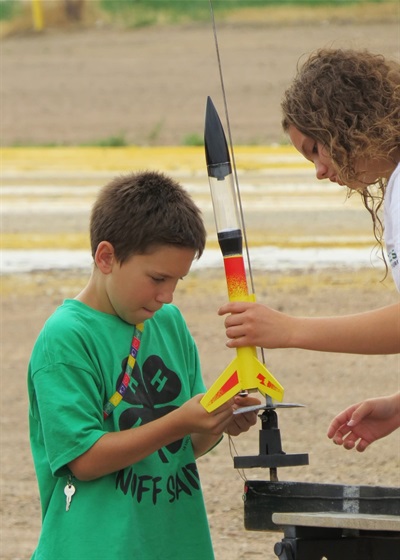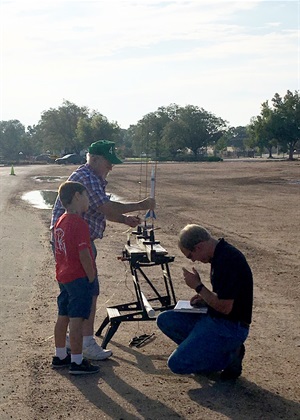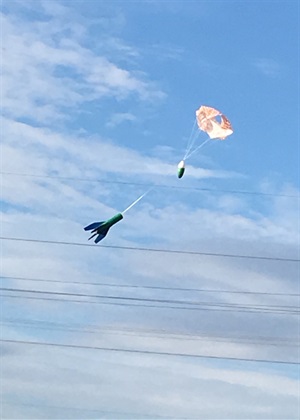4-H Members Reach New Heights with Model Rocketry Project
By Shaley Dehner, Weld County Communications Specialist, Photos by Kimberly Sterkel
Model rocketry began as a Weld County Fair 4-H project in Galeton, Colo. in the late 1960s. Being a state 4-H project, Weld County was inclined to adopt it as a county project.
Phil Rouse, 4-H Club Model Rocketry Project Leader, has been teaching children and adults about model rocketry since 1980. When asked how he came to be involved with this project he smiled and said, “Because of my son. He was an 8-year-old who was in to 4-H and he wanted to build rockets.”
 Model rockets are constructed from safe materials such as cardboard, plastic and wood. They are fueled by single-use motors, which are commercially manufactured and typically contain a parachute, streamer or other recovery device that allows them to land gently for later re-flight.
Model rockets are constructed from safe materials such as cardboard, plastic and wood. They are fueled by single-use motors, which are commercially manufactured and typically contain a parachute, streamer or other recovery device that allows them to land gently for later re-flight.
Currently, model rocketry has five levels. They used to have six, but Rouse said the level five rocket was the hardest for the kids to achieve because Estes Industries was not building anything. So now, they go from level one through four, skip five, then go onto six.
Levels one and two focus on learning the theories behind model rocketry, such as Newtons Law. Kids learn about trigonometry and other physics laws as well. At the end of level one, the kids are expected to be able to sit with a judge and point to what the different parts of the model rockets are. Levels three and four focus on types of engines, building the rocket, and how to launch the rocket. Level six allows 4-Hers to design and build their own rocket!
“It’s fun to watch the kids grow. We have kids that were building rockets in 4-H and have come back as parents to help their kids build rockets,” Rouse said.
 Rouse recalls that when he started helping with model rocketry, they used to judge the rockets and immediately launch the rockets east of the fair grandstands. This was before Fly Day competitions became a Weld County Fair tradition.
Rouse recalls that when he started helping with model rocketry, they used to judge the rockets and immediately launch the rockets east of the fair grandstands. This was before Fly Day competitions became a Weld County Fair tradition.
“It was kind of funny,” Rouse exclaimed. “We never lost any rockets across the street, which I thought we would.”
Rouse encourages 4-Hers to build two rockets each year; one is their show rocket for the demonstration and exhibition interview that is put on display during fair week while the other is launched at the Fly Day competition.
“The main goal of Fly Day competitions is for the kids to build a rocket using the smallest engine suggested by the manufacturer then launch it and see how close it lands to the Launchpad,” Rouse explained. “Of course, we have had rockets that have lost fins mid-flight so we help them repair their rocket for the second launch.”
Rouse said there have been many rockets that they haven’t found over the years after launching them. They have lost rockets to irrigation ditches, trees, alfalfa fields and corn fields. But most of them come back down close to the Launchpad.
Model rocketry was an open class exhibition for children and adults until 2006 when it was restricted to children between the ages of 8 to 12 or 13 to 18 only. There are two classes so that the kids are competing against others whom are close to their age. But Rouse wishes it were still for adults as well and believes the hobby has value for parents whose kids are interested in model rocketry.
“As a parent, you should build your own model rocket because when you run into a problem or aren’t understanding something, then you can help your child when they come across the same problem,” Rouse said. “It’s a good father, son project but it is also a good father, daughter project.”
Rouse also explained that model rocketry is well-liked by girls, and often, they walk away winners at 4-H events.
“I had a girl that went to the state 4-H model rocketry competition and she won; twice,” he chuckled! “That was neat to see. She carried her trophy, that was as big as her, around the fair the rest of the day.”
Rouse also encourages his 4-Hers to complete one other project aside from model rocketry; whether that be showing animals or animal science.
Teaching the children safety is one of the most important parts of model rocketry. Rouse tells each model rocketeer that they must turn 365 degrees at the Launchpad and look up at the sky to make sure there are no flying aircraft present before launching their rocket. This includes the feathered kind.
“Due to all of the water we have here, there are a lot of pelicans around. I tell the kids that they need to make sure there are no pelicans flying overhead because we don’t want to shoot them down,” he chuckled.
As for the number of children interested in model rocketry as a 4-H project, Rouse said Weld County has around 40 to 50 kids; which is more than most counties in Colorado. And some of them go on to have careers related to their roots in 4-H model rocketry.
 “We’ve had kids that have gone on to military flying or launching rockets,” Rouse explained. “Art Hoag was in our 4-H model rocketry project here in Weld County when he was younger. But these little rockets were not as challenging as the bigger ones for him. Art’s last rocket, which is 21 feet tall, weighs 365 pounds and launched 18,000 feet, is on permanent display at the Denver Museum of Nature and Science. Art is now a pilot for United Airlines and he helps judge at the Weld County Fair as well. It’s neat to see his journey come full circle in a way.”
“We’ve had kids that have gone on to military flying or launching rockets,” Rouse explained. “Art Hoag was in our 4-H model rocketry project here in Weld County when he was younger. But these little rockets were not as challenging as the bigger ones for him. Art’s last rocket, which is 21 feet tall, weighs 365 pounds and launched 18,000 feet, is on permanent display at the Denver Museum of Nature and Science. Art is now a pilot for United Airlines and he helps judge at the Weld County Fair as well. It’s neat to see his journey come full circle in a way.”
Although nothing special is planned related to model rocketry at this year’s fair, Rouse wants to impress upon the kids that this is the 100th Weld County Fair and that the fair has come a long way since 1918. Most importantly, Rouse loves to see the children learn about model rocketry and see the joy they get from launching their rockets.
“Even though the kids are launching smaller rockets, they act as if their rockets are big,” Rouse laughed!
A TRUE STAR
Rocket Fly Day wouldn’t be what it is today, if it hadn’t been for Rouse. Mark Cronquist, a Weld County 4-H Extension Agent from 1980 to 2004, commends Rouse for his great impact on the model rocketry program. “We needed someone who was not only up for the fun aspects of putting the model rockets together, but who was also dedicated to the educational process,” he said. “It turns out Phil was just the guy!”
Rouse initiated the rocket launch program when he started his career as a Weld County 4-H Club Model Rocketry Project Leader since many kids would bring their rockets to the fair having never launched them. Cronquist said Rouse’s lighthearted ability to attract and educate 4-H youngsters is truly rare.
“He would tease the kids if they brought a rocket to the meetings that wasn’t quite up to snuff,” Cronquist joked. “But more importantly, he caught them doing things right and did a really good job letting them know it.”
The Weld County Fair thanks Rouse for his continued service to the youth of Weld County through guiding and mentoring them in the 4-H model rocketry program!